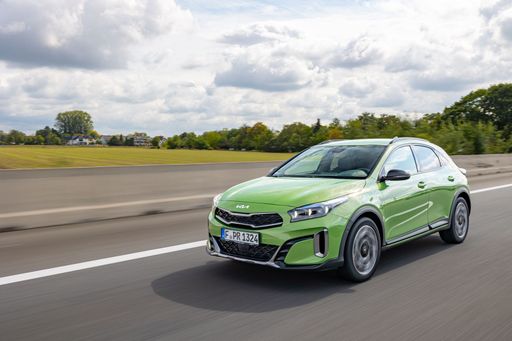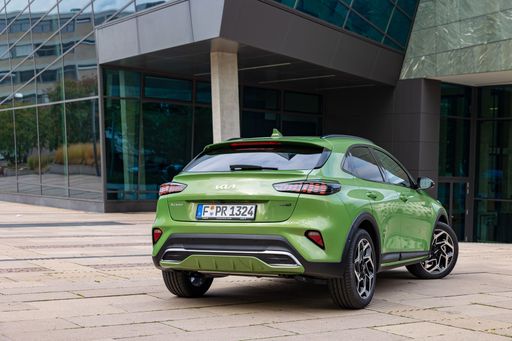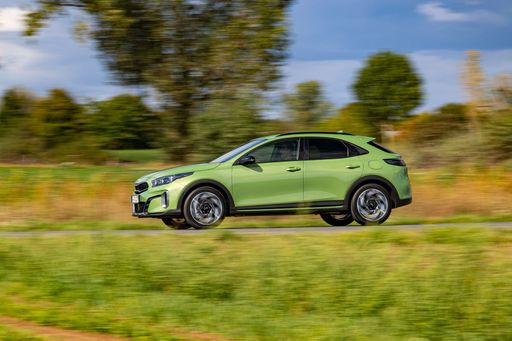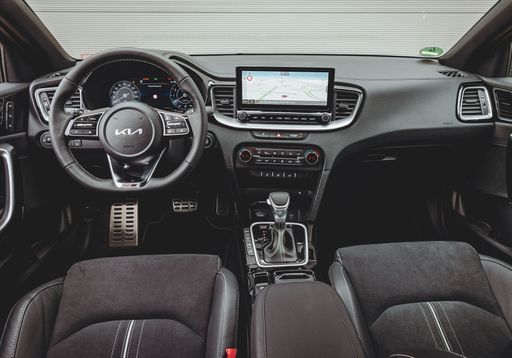Kia XCeed VS Maxus Deliver 3 – Specs, Efficiency & Price Comparison
Which model is the better choice – the Kia XCeed or the Maxus Deliver 3? We compare performance (140 HP vs 160 HP), boot capacity (426 L vs ), efficiency (6.30 L vs 20.20 kWh), and of course, the price (23700 £ vs 33600 £).
Find out now which car fits your needs better!
The Kia XCeed (SUV) is powered by a Petrol engine and comes with a Manuel or Automatic transmission. In comparison, the Maxus Deliver 3 (Cargo Van) features a Electric engine and a Automatic gearbox.
When it comes to boot capacity, the Kia XCeed offers 426 L, while the Maxus Deliver 3 provides – depending on what matters most to you. If you’re looking for more power, you’ll need to decide whether the 140 HP of the Kia XCeed or the 160 HP of the Maxus Deliver 3 suits your needs better.
There are also differences in efficiency: 6.30 L vs 20.20 kWh. In terms of price, the Kia XCeed starts at 23700 £, while the Maxus Deliver 3 is available from 33600 £.
Compare all the key specs now and find out which model fits your lifestyle best!
Kia XCeed
The Kia XCeed offers a stylish and modern design, blending the sportiness of a coupé with the practicality of an SUV. Its interior is well-crafted, featuring high-quality materials and a range of advanced technology to enhance the driving experience. With an emphasis on comfort and efficiency, the XCeed provides a compelling option for those seeking a versatile and dynamic vehicle.
details @ press.kia.com
@ press.kia.com
 @ press.kia.com
@ press.kia.com
 @ press.kia.com
@ press.kia.com
 @ press.kia.com
@ press.kia.com
Maxus Deliver 3
The Maxus Deliver 3 exemplifies modern electric van design with its emphasis on both efficiency and practicality. Its spacious cargo area and easy manoeuvrability make it an ideal choice for urban deliveries. Coupled with advanced safety features, it provides a reliable option for businesses looking to transition to environmentally friendly transportation.
details

|
|
|
|
|
Costs and Consumption |
|
|---|---|
|
Price
23700 - 31400 £
|
Price
33600 £
|
|
Consumption L/100km
6.3 - 6.5 L
|
Consumption L/100km
-
|
|
Consumption kWh/100km
-
|
Consumption kWh/100km
20.20 kWh
|
|
Electric Range
-
|
Electric Range
269 km
|
|
Battery Capacity
-
|
Battery Capacity
-
|
|
co2
143 - 148 g/km
|
co2
0 g/km
|
|
Fuel tank capacity
50 L
|
Fuel tank capacity
-
|
Dimensions and Body |
|
|---|---|
|
Body Type
SUV
|
Body Type
Cargo Van
|
|
Seats
5
|
Seats
2
|
|
Doors
5
|
Doors
4
|
|
Curb weight
1347 - 1400 kg
|
Curb weight
1690 kg
|
|
Trunk capacity
426 L
|
Trunk capacity
-
|
|
Length
4395 mm
|
Length
4555 mm
|
|
Width
1826 mm
|
Width
1780 mm
|
|
Height
1495 mm
|
Height
1900 mm
|
|
Payload
470 - 473 kg
|
Payload
970 kg
|
Engine and Performance |
|
|---|---|
|
Engine Type
Petrol
|
Engine Type
Electric
|
|
Transmission
Manuel, Automatic
|
Transmission
Automatic
|
|
Transmission Detail
Schaltgetriebe, Automat. Schaltgetriebe (Doppelkupplung)
|
Transmission Detail
-
|
|
Drive Type
Front-Wheel Drive
|
Drive Type
Front-Wheel Drive
|
|
Power HP
100 - 140 HP
|
Power HP
160 HP
|
|
Acceleration 0-100km/h
10.2 - 13.4 s
|
Acceleration 0-100km/h
8.90 s
|
|
Max Speed
174 - 195 km/h
|
Max Speed
120 km/h
|
|
Torque
172 - 253 Nm
|
Torque
225 Nm
|
|
Number of Cylinders
3 - 4
|
Number of Cylinders
-
|
|
Power kW
74 - 103 kW
|
Power kW
118 kW
|
|
Engine capacity
998 - 1482 cm3
|
Engine capacity
-
|
General |
|
|---|---|
|
Model Year
2024
|
Model Year
2023
|
|
CO2 Efficiency Class
E
|
CO2 Efficiency Class
A
|
|
Brand
Kia
|
Brand
Maxus
|
Kia XCeed
The Striking Design of the Kia XCeed
The Kia XCeed presents a refreshing take on the compact SUV segment with its sleek silhouette and expressive design. Sporting an eye-catching front grille, LED headlights, and a stylish coupé-like roofline, it combines aesthetics with aerodynamics. This design not only enhances its road presence but also contributes to fuel efficiency.
Dynamic Engine Options
Underneath the stylish bonnet of the Kia XCeed is a range of lively petrol engines. With options extending from a 1.0-litre T-GDI producing 100 PS to a more robust 1.5-litre T-GDI pumping out 140 PS, drivers can select the ideal balance of power and efficiency. The engines are paired with either a manual or a dual-clutch automatic transmission, delivering a smooth and responsive driving experience.
Innovative Features and Technology
The Kia XCeed is not just about looks, but also brains. It comes loaded with innovative features like the advanced driver assistance system, providing a safer drive. The infotainment system is seamlessly integrated with smartphone capabilities, ensuring that drivers and passengers stay connected and entertained effortlessly.
Practicality Meets Performance
Despite its sleek appearance, the Kia XCeed does not compromise on practicality. It offers a generous boot space of 426 litres, making it an excellent choice for families and adventurers alike. The interior is designed for comfort, with ample headroom and legroom for all passengers.
Fuel Efficiency and Environmental Friendliness
Efficiency is at the heart of the Kia XCeed, with a fuel consumption range of 6.3 to 6.5 litres per 100 km. These figures position the XCeed as a competitive option for environmentally conscious drivers, despite the engine performance. The CO2 emissions stay within a moderate range, aligning with its commitment to sustainability.
Cost of Ownership
Owning a Kia XCeed is not only about driving joy but also financial prudence. With monthly costs ranging from €922 to €1,058 and a reasonable maintenance cost per kilometre, it is a sensible choice for those looking to minimise running expenses.
Conclusion: The Future of Compact SUVs
The Kia XCeed sets a new standard for what compact SUVs can offer, blending exciting design, dynamic performance, and cutting-edge technology. It's an ideal vehicle for those who want a mix of style, practicality, and efficiency in their automotive choice.
Maxus Deliver 3
Introducing the Maxus Deliver 3: A Compact Electric Transporter
The Maxus Deliver 3 is an innovative addition to the world of compact electric transporters, offering a combination of cutting-edge technology and robust design tailored for urban and suburban logistics. Available in different configurations, the Deliver 3 sets new standards in the small van category, making it an appealing option for businesses committed to sustainable solutions.
Electric Performance That Delivers
At the heart of the Maxus Deliver 3 is an electric powertrain that brings efficiency and power to the forefront. The model hosts a 118 kW (160 PS) electric motor driving the front wheels, which is complemented by an automatic transmission with a reduction gearbox. This setup not only provides a seamless driving experience but also ensures zero emissions with a CO2 efficiency class of A.
Impressive Range and Efficiency
The Deliver 3 offers a practical driving range between 228 and 238 kilometres on a full charge, making it an ideal choice for businesses operating in densely packed urban areas. Efficiency is key, with energy consumption ranging from 22.9 to 23.6 kWh per 100 kilometres, balancing the demands of delivery operations with eco-friendly efficiency.
Built for Everyday Utility
Maxus's thoughtful design shines through in the Deliver 3's build. Measuring between 4,555 mm and 5,145 mm in length, and with a width of 1,780 mm, it manoeuvres through tight streets and parking spaces effortlessly. With a high roof height of up to 1,915 mm, the vehicle also ensures easy navigation through low-clearance zones.
Payload and Capacity
The vehicle is designed for efficiency not only in energy use but also in cargo capacity, supporting a payload of between 835 and 860 kg. This impressive figure, combined with a versatile cargo space, makes the Deliver 3 an ideal partner for carrying varied loads, whether parcels or packages.
Driving Experience and Comfort
Inside, the Deliver 3 is equipped with a driver-centric cabin offering supportive seats for two occupants and intuitive controls that enhance the driving experience. Its straightforward interface removes distractions, allowing drivers to focus on the road, while the robust 225 Nm torque ensures consistent performance, even with a full load.
Safety and Innovation
The Maxus Deliver 3 doesn't compromise on safety. It includes a range of standard safety features designed to protect drivers and cargo alike. The model year 2023 delivers the latest in safety technology to keep you secure, making it a top choice for conscientious fleet operators.
Conclusion: A Commitment to a Cleaner Future
Overall, the Maxus Deliver 3 stands out as a versatile and economical choice in the electric van segment. With zero emissions contributing to a cleaner environment, it reflects the shift towards sustainable business practices. For small to medium-sized enterprises, the Deliver 3 is more than just a vehicle—it's a commitment to innovation and the future of logistics.
The prices and data displayed are estimates based on German list prices and may vary by country. This information is not legally binding.
